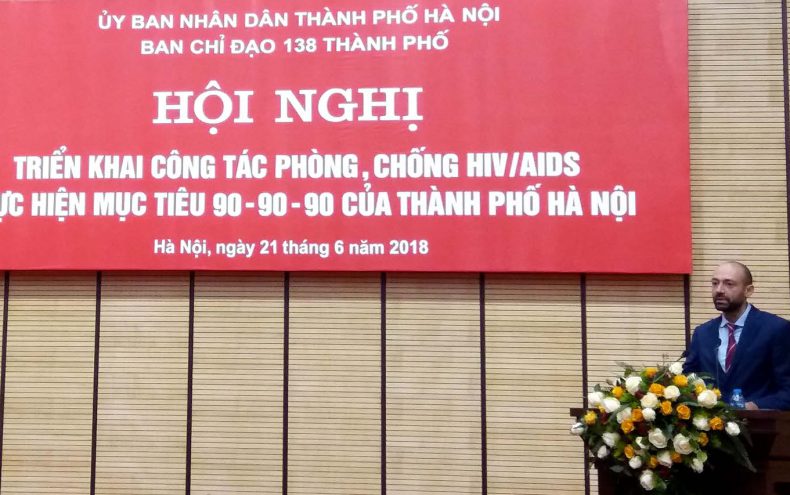Ha Noi’s Meeting on Fast Track and Implementing 90-90-90 Targets
Your Excellency, Le Hong Son, Vice Chairman of Ha Noi People’s Committee,
Your Excellency, Nguyen Thanh Long, Vice Minister of Health,
Leaders of VAAC, Ha Noi Department of Health and Ha Noi Centre for Preventive Medicines,
Distinguished guests, colleagues and friends,
Good afternoon.
In September 2015, all member states of the UN adopted the 2030 agenda for Sustainable Development with its 17 goals. “Ending AIDS” is a cross-cutting theme across several goals in the SDGs, and specifically targeted in Goal #3 on good health and well-being for all. In line with the goal, UNAIDS developed the Fast-Track Strategy to accelerate the HIV response toward Ending AIDS and leaving no one behind.
In 2016, at a UN High Level Meeting on AIDS, the international community reaffirmed their commitment to end the AIDS epidemic by 2030. At this meeting member states adopted a political declaration which provides a global mandate to fast track the HIV response. Deputy Prime Minister Vu Duc, led a delegation from Viet Nam to this high-level meeting. Standing beside a woman living with HIV, DPM Dam addressed the General Assembly, and requested the world not to become complacent, to increase efforts, and to leave no one behind.
Viet Nam has since institutionalized fast track targets on HIV in its 2016-2020 five year targeted program on health and population, and under the highest direction to end AIDS by 2030 provided by the communist party central committee’s recent resolution on healthcare.
An entry point for progress toward all the fast-track goals and targets, is the achievement of the 90-90-90 treatment target by 2020. 90-90-90 achievement is where 90% of people living with HIV know their status; 90% of people who know their HIV status are accessing treatment; and 90% of people on treatment have suppressed viral loads.
When this three-part target is achieved, nearly three-quarters of all people living with HIV worldwide will be virally suppressed. Our forecasts suggest that achieving these targets by 2020 will enable the world to end the AIDS epidemic by 2030, which in turn will generate profound health and economic benefits.
Life-long, uninterrupted HIV treatment is highly effective. It allows people living with HIV to live a long, healthy and productive life. It also reduces onward transmission of HIV to reduce new HIV infections in the population. So we need to reach and encourage people, especially those at higher risk, to test and start treatment as soon as possible.
Viet Nam is proudly the first country in Asia and the Pacific to commit to these 90-90-90 targets. And these targets are achievable, given the latest innovations in the HIV response and Viet Nam’s history of evidence-based innovation and scale-up.
Viet Nam has had an effective HIV response in the last decade. Nearly half a million HIV infections were averted between 2000 and 2016. And 150k lives were saved from AIDS-related deaths, due to the strong impact of the Viet Nam’s HIV response. Currently 50% of people living with HIV are on treatment, which is twice the number treated in 2010. However, that also means 50% are still not on treatment.
That is why we need to fast-track. Despite the gains in reduced infections and averted deaths, there are still nearly 11,000 new HIV infections and 8000 AIDS related deaths every year in Viet Nam. AIDS is clearly not over.
Ladies and gentlemen,
Viet Nam is among the 30 countries globally that account for more than 80% of the world’s new HIV infections. Within these fast-track countries, key populations in large cities have a higher HIV prevalence than other areas.
Cities and urban areas have a comparative advantage and offer important opportunities for effective action on HIV. Ha Noi as the capital city, and a political, social, and economic hub, can lead national fast-tracking efforts and set an example for other cities regionally. Metropolitan cities like Hanoi have certain advantages, such as stronger health systems and infrastructures to reach large numbers of people. They offer spaces for learning, creativity and innovation, and the populations often have higher incomes and education levels.
But cities also have their own challenges. Urban dynamics such as migration, unemployment, social and economic inequities can exacerbate the risk and vulnerabilities to diseases such as HIV and TB. Cities provide increased opportunities for behaviours that place one at risk, and greater sexual networks. All these factors contribute to an often higher HIV transmission risk in urban areas.
We can overcome these challenges by focusing investments to have the greatest impact. Specifically:
Do the rights things, in the right places, and for the right people. That includes creating an environment where people living with HIV and those at higher risk of HIV infection can easily access the prevention and treatment services that they need, free from stigma and discrimination.
Continue surveillance and strategic analysis of gaps to inform our programs.
Embrace innovative initiatives that provide greater access to HIV services for PLHIV and key populations.
Foster strong and inclusive partnerships for greater impact, including collaboration with central and provincial government institutes, legislative leaders, private sector, donors, academia, and civil society.
If we can do these things and do them right and at scale, we can bend the epidemic curve. And that’s what fast-track is about: selecting the right trajectory for the country.
We trust that with strong commitment and leadership, with experiences and achievements thus far in the response to HIV and with support from development partners, Hanoi will be successful in fast track efforts.
Together, we can save lives, we can end AIDS as a public health threat, and we can achieve the SDGs by 2030.
As Deputy Prime Minister Vu Duc Dam has urged us, let us join hands to achieve the 90-90-90 targets with 100, 100, 100 percent commitment and even more.
Xin cam on!




